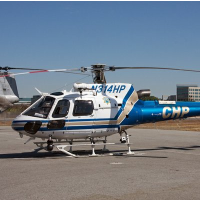Independent State Analyst Questions Highway Patrol Use of Aircraft
 (photo: Scott Loftesness, Flickr)
(photo: Scott Loftesness, Flickr)
In the age of drones, does the California Highway Patrol (CHP) really need to keep its fleet of 30 aircraft flying?
For now, the CHP says “yes” and wants to replace four aging aircraft in the coming year (two planes and two helicopters), with an eye to replacing them all as they hit 10,000 miles in the sky.
The nonpartisan Legislative Analyst’s Office (LAO) disagrees. Governor Jerry Brown’s 2014-15 budget (pdf) proposes $16 million for the aircraft and eventual shrinkage of the fleet to 26. The LAO recommended that the Legislature ground the plan.
The analyst questioned whether the CHP really needed 26 aircraft to cover eight geographic divisions and argued that making this purchase locks in a schedule of replacement that may be unnecessary. The CHP wants two airplanes and one helicopter for each division and two aircraft in reserve.
The LAO said the CHP failed to make a case for the aircraft although the agency was specifically asked to do so last year when it received $17 million to replace four other aircraft. The CHP was supposed to file a report that included “an overall assessment of its fleet needs” but all it produced was a report that “simply states that CHP needs 26 aircraft to achieve its goal to perform 26,000 total flight hours per year and provide each CHP division with three aircraft.”
They want them because they want them.
The analyst wondered if the CHP’s needs and schedule for replacement might be affected in the future by allied agencies requiring less assistance and aircraft lasting longer. The office suggested two aircraft per division might be sufficient.
The analyst also questioned the appropriateness of having the state’s Motor Vehicle Account (MVA) be the sole funding source for the aircraft. Around 91% of the CHP expenditures come from the account, which is funded primarily by driver and vehicle registration fees. Another $14 million in MVA funds would be used annually to buy three aircraft in each of the following two years, and $8 million for two aircraft every year thereafter.
The funding source may be unconstitutional now that the CHP has assumed duties in support of the federal Department of Homeland Security. The LAO wrote:
“Under Article XIX of the State Constitution, any revenues from fees and taxes on vehicles or their use—such as driver license and vehicle registration fees—can only be used for the state administration and enforcement of laws regulating the use, operation, or regulation of vehicles used upon the public streets and highways.”
Patrolling the state’s water and electrical infrastructure, like dams and utilities, might not fit that definition. Some of the CHP’s flying assistance to other state agencies also may not be legal, the analyst said.
The CHP has been in the air for more than 35 years. They had 14 planes in 1984 and the same number 16 years later. In 2006, CHP Sergeant Michael Texiera described their use as “pretty much a 50/50 split between homeland security and ground enforcement/surveillance.” They look for speeders, monitor transportation assets and utilities, help at special events, patrol rural roadways and respond to emergencies.
Although the Legislative Analyst didn’t mention it, one form of technology could have a pronounced impact on the CHP’s aerial assignments. When highway signs began appearing in the Bay Area last July warning motorists, “Speed Enforced by Drones,” the idea didn’t seem far-fetched to many.
The signs turned out to be the work of a prankster and the CHP denied having any drones. But they could soon. The drone market is expected to grow 700% by 2018 and California is drafting legislation for their use by law enforcement. The Assembly passed AB 1327 in January and it is under consideration in the Senate.
The bill authorizes law enforcement agencies to use drones if they have a warrant. They would also be allowed to use drones without a warrant in an emergency or “to inspect state parks and wilderness areas for ‘illegal vegetation.’ ”
The LAO might not approve of motor vehicle fees funding the hunt for marijuana. Civilians might take note of the bill’s prohibition against the “weaponizing” of drones—“unless authorized by federal law.”
–Ken Broder
To Learn More:
Calif. Analysts Doubt Highway Patrol Aircraft Need (by Justin Pritchard, Associated Press)
Do Police Really Use Aircraft to Enforce Speed Limits? (by Jason Bittel, Slate)
Just a Drone Prank or Signs of the Times in the Bay Area? (by Ken Broder, AllGov California)
2014-15 Budget Transportation Proposals (Legislative Analyst’s Office) (pdf)
- Top Stories
- Controversies
- Where is the Money Going?
- California and the Nation
- Appointments and Resignations
- Unusual News
- Latest News
- California Forbids U.S. Immigration Agents from Pretending to be Police
- California Lawmakers Urged to Strip “Self-Dealing” Tax Board of Its Duties
- Big Oil’s Grip on California
- Santa Cruz Police See Homeland Security Betrayal in Use of Gang Roundup as Cover for Immigration Raid
- Oil Companies Face Deadline to Stop Polluting California Groundwater





